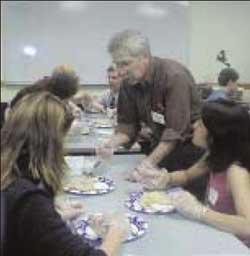Vital Signs:
Learning medicine
with kiwifruits
and chicken parts
Family physicians do some of almost everything-from detecting cancer to stitching up playground lacerations. The annual DMS "Skills Night," organized by the Family Medicine Interest Group, is a way to introduce students interested in family medicine to some of the diverse capabilities they'll soon be expected to master.
Dr. Catherine Pipas, assistant dean for medical education and director of the family medicine clerkship, welcomed attendees to this year's Skills Night by acknowledging the hard work of the students who had equipped and assembled 60 students and 15 volunteer family physicians in one place at one time.

|
| Using chicken parts on paper plates, family physician Don Kollisch (standing) demonstrates suturing techniques. |
In 25-minute sessions, firstand second-year students-plus a few Dartmouth undergraduate premeds-rotated through minicourses in casting and splinting; endometrial biopsies; testicular exams; suturing; and osteopathic manipulation.
Casts: Dr. James Schneid, an associate professor of community and family medicine, gave a brief introduction to casting. He noted that immobilizing fractures is unique to Western medicine and discussed the choice of materials-plaster of paris is cheap and available but not durable, while fiberglass and synthetics are durable but expensive and harder to apply. Then he and several colleagues showed the students how to cut stockinette, roll padding, and wrap wet casting around each other's fingers. Finishing off the casts, Schneid gave some advice on
Aesthetics: If the wrapping pokes out the top of the cast, he said, or the cast is rough, "people look at that and think you're less of a doctor. And," he added, "patients will judge you on the number of colors you offer."
Arm: Then, pointing out that an important part of family medicine is knowing when to stabilize a problem and send a patient to a specialist, Schneid showed how to apply a "sugar tong" device to a badly broken arm to immobilize it while the patient is transferred elsewhere.
In another room, Dr. Stephanie Calkins, an assistant professor of community and family medicine, was one of four physicians demonstrating suturing techniques. Raw chicken quarters were laid out on tables, and the students first practiced making a surgical incision and then tried using a tiny, curved needle to sew the edges of the incision together again. The procedure is more like fly-tying than sewing, and doing the knots correctly matters. Dr. Donald Kollisch, an associate professor of community and family medicine, hovered over the students as they tried to make their knots square and flat. "When you're in the OR," he advised, "you'd better throw squares, not grannies."
Kiwi: In yet another room, volunteers showed how to take an endometrial biopsy, proving that kiwis are a truly versatile little fruit. Students practiced inserting a speculum into a plastic model of the female anatomy, clamping a kiwi in place, and then inserting a pipette to withdraw a sample of . . . kiwi pulp and seeds. Few students seemed squeamish, and they got pointers along the way about sensitivity and technique. For example, they were advised to line up the sterile instruments in the order they're going to be used.
There were also demonstrations of osteopathic manipulation and of testicular exams. As the students rotated through the stations, they'd stop by Chilcott Auditorium for a bit more Chinese food or another brownie. The atmosphere was relaxed, but it didn't lessen the intensity with which students wielded needles on chicken parts or extracted samples of kiwifruit.
Maybe the best measure of the event's success was that for some students, it wasn't their first Skills Night; they'd been before and relished the chance to spend a few more hours sampling the myriad family-medicine arts.
If you would like to offer any feedback about this article, we would welcome getting your comments at DartMed@Dartmouth.edu.
